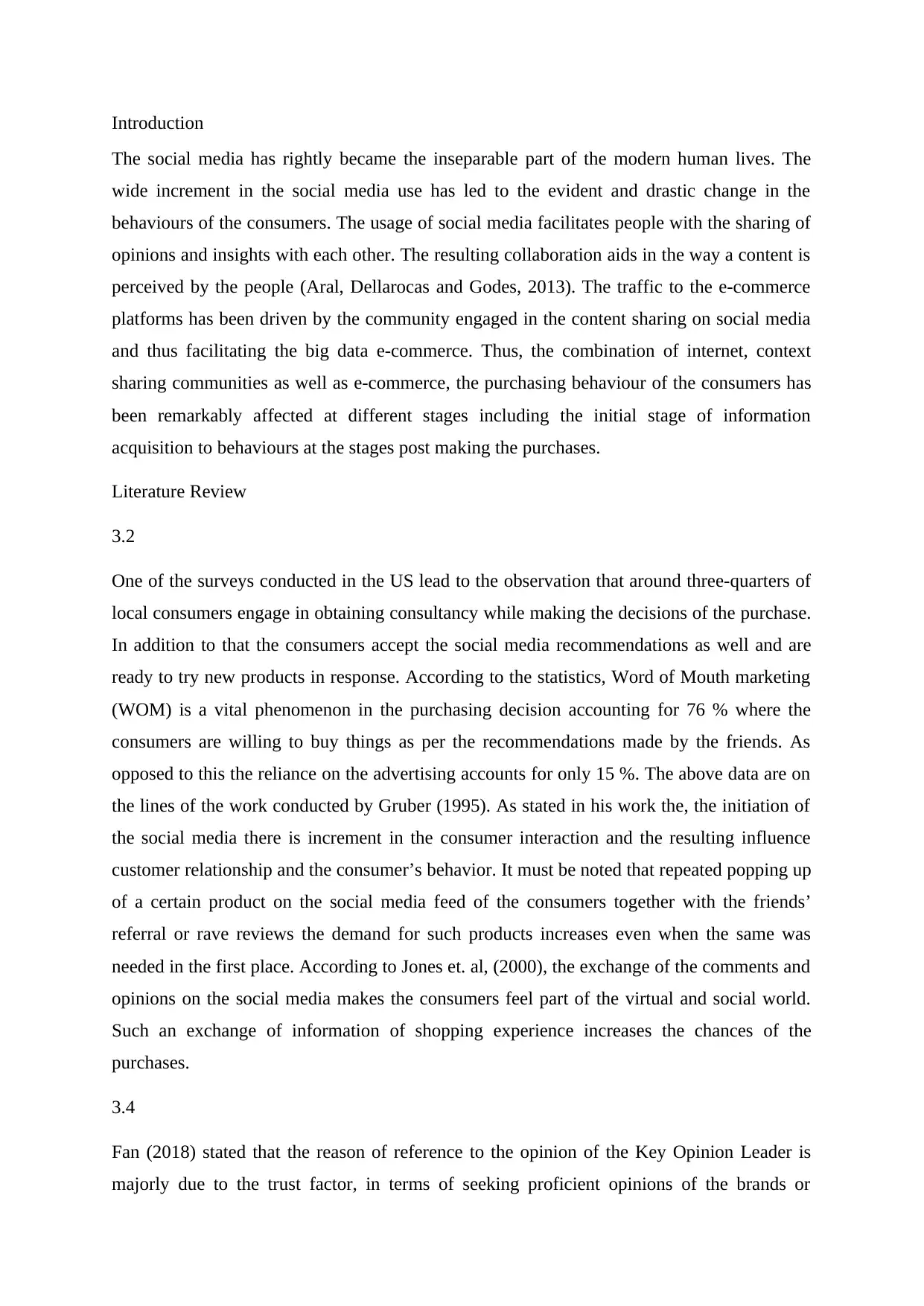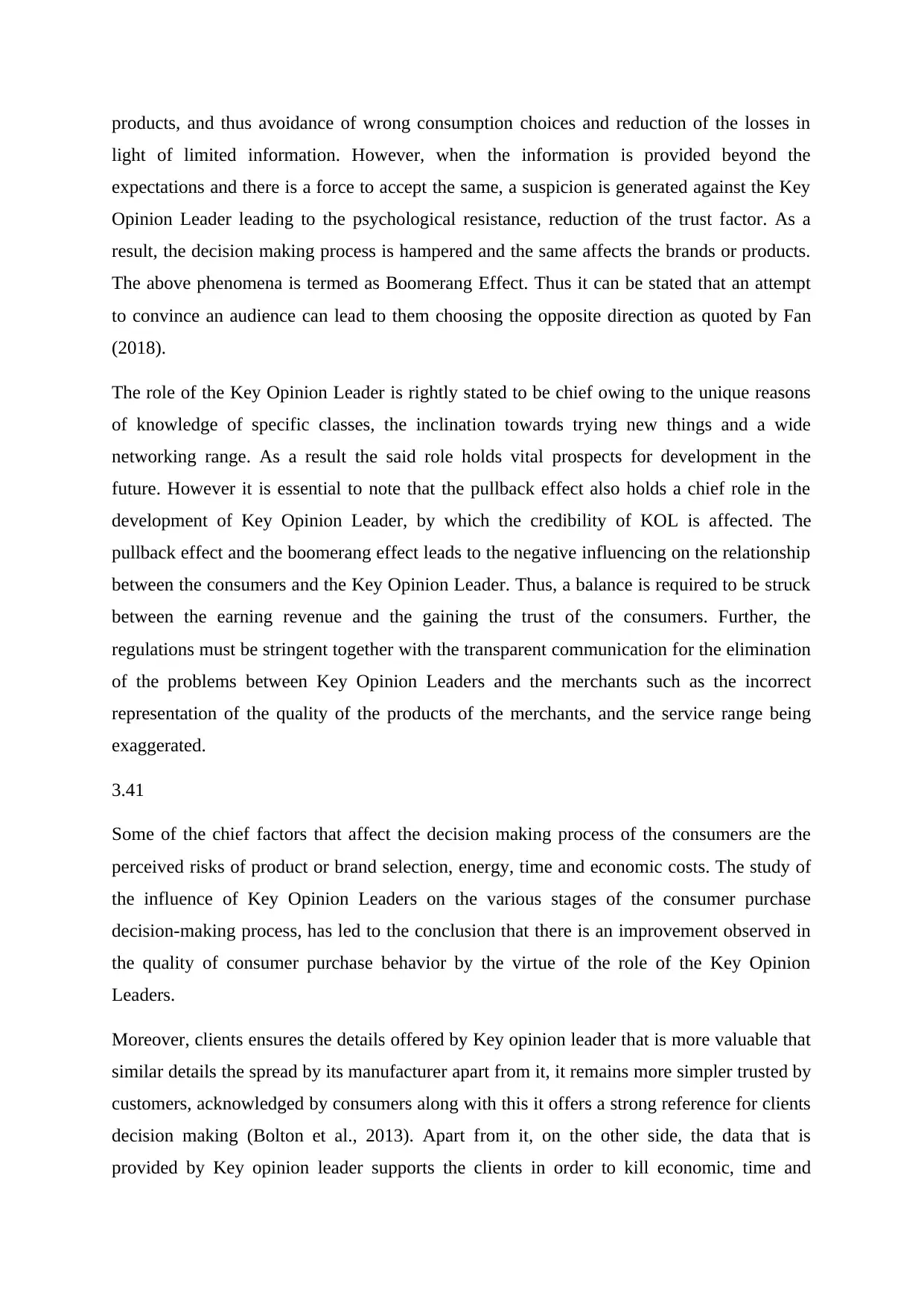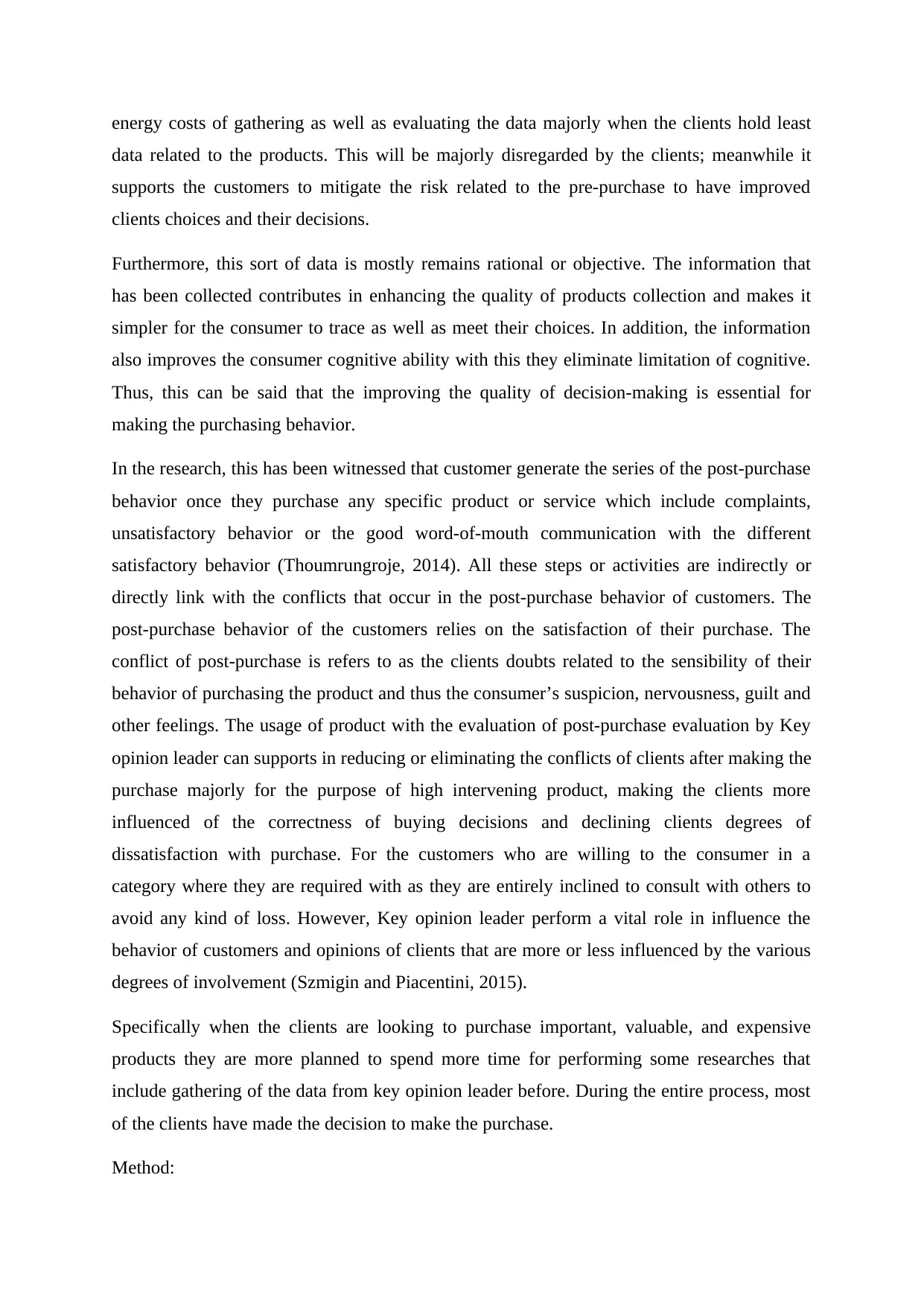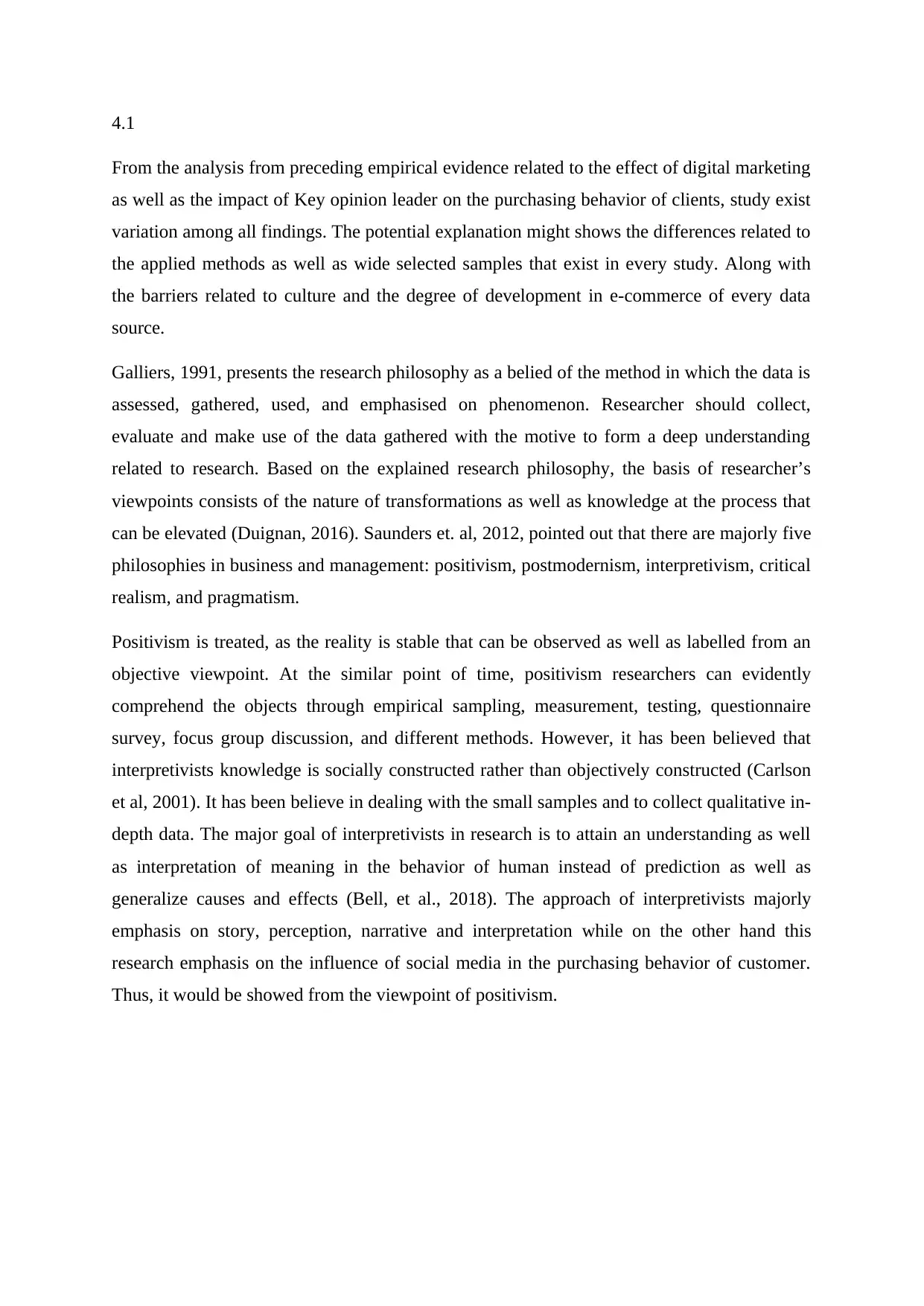An In-Depth Analysis: Social Media's Impact on Consumer Behavior
VerifiedAdded on 2022/10/10
|4
|1743
|15
Report
AI Summary
This report provides a comprehensive analysis of the significant impact of social media on contemporary consumer behavior. It explores how social platforms influence consumers across various stages, from initial information gathering to post-purchase actions. The study delves into key concepts such as word-of-mouth marketing, the role of key opinion leaders (KOLs), and their effects on purchasing decisions. It examines consumer trust, perceived risks, and the influence of KOLs on product choices. The report also investigates the interplay between social media, e-commerce, and consumer behavior, highlighting the importance of understanding these dynamics for effective marketing strategies. Furthermore, it discusses the methods used to analyze the data, considering research philosophies like positivism and interpretivism, offering a well-rounded perspective on this crucial topic. The report concludes by emphasizing the need for transparent communication and stringent regulations to address potential issues between KOLs and merchants.

Introduction
The social media has rightly became the inseparable part of the modern human lives. The
wide increment in the social media use has led to the evident and drastic change in the
behaviours of the consumers. The usage of social media facilitates people with the sharing of
opinions and insights with each other. The resulting collaboration aids in the way a content is
perceived by the people (Aral, Dellarocas and Godes, 2013). The traffic to the e-commerce
platforms has been driven by the community engaged in the content sharing on social media
and thus facilitating the big data e-commerce. Thus, the combination of internet, context
sharing communities as well as e-commerce, the purchasing behaviour of the consumers has
been remarkably affected at different stages including the initial stage of information
acquisition to behaviours at the stages post making the purchases.
Literature Review
3.2
One of the surveys conducted in the US lead to the observation that around three-quarters of
local consumers engage in obtaining consultancy while making the decisions of the purchase.
In addition to that the consumers accept the social media recommendations as well and are
ready to try new products in response. According to the statistics, Word of Mouth marketing
(WOM) is a vital phenomenon in the purchasing decision accounting for 76 % where the
consumers are willing to buy things as per the recommendations made by the friends. As
opposed to this the reliance on the advertising accounts for only 15 %. The above data are on
the lines of the work conducted by Gruber (1995). As stated in his work the, the initiation of
the social media there is increment in the consumer interaction and the resulting influence
customer relationship and the consumer’s behavior. It must be noted that repeated popping up
of a certain product on the social media feed of the consumers together with the friends’
referral or rave reviews the demand for such products increases even when the same was
needed in the first place. According to Jones et. al, (2000), the exchange of the comments and
opinions on the social media makes the consumers feel part of the virtual and social world.
Such an exchange of information of shopping experience increases the chances of the
purchases.
3.4
Fan (2018) stated that the reason of reference to the opinion of the Key Opinion Leader is
majorly due to the trust factor, in terms of seeking proficient opinions of the brands or
The social media has rightly became the inseparable part of the modern human lives. The
wide increment in the social media use has led to the evident and drastic change in the
behaviours of the consumers. The usage of social media facilitates people with the sharing of
opinions and insights with each other. The resulting collaboration aids in the way a content is
perceived by the people (Aral, Dellarocas and Godes, 2013). The traffic to the e-commerce
platforms has been driven by the community engaged in the content sharing on social media
and thus facilitating the big data e-commerce. Thus, the combination of internet, context
sharing communities as well as e-commerce, the purchasing behaviour of the consumers has
been remarkably affected at different stages including the initial stage of information
acquisition to behaviours at the stages post making the purchases.
Literature Review
3.2
One of the surveys conducted in the US lead to the observation that around three-quarters of
local consumers engage in obtaining consultancy while making the decisions of the purchase.
In addition to that the consumers accept the social media recommendations as well and are
ready to try new products in response. According to the statistics, Word of Mouth marketing
(WOM) is a vital phenomenon in the purchasing decision accounting for 76 % where the
consumers are willing to buy things as per the recommendations made by the friends. As
opposed to this the reliance on the advertising accounts for only 15 %. The above data are on
the lines of the work conducted by Gruber (1995). As stated in his work the, the initiation of
the social media there is increment in the consumer interaction and the resulting influence
customer relationship and the consumer’s behavior. It must be noted that repeated popping up
of a certain product on the social media feed of the consumers together with the friends’
referral or rave reviews the demand for such products increases even when the same was
needed in the first place. According to Jones et. al, (2000), the exchange of the comments and
opinions on the social media makes the consumers feel part of the virtual and social world.
Such an exchange of information of shopping experience increases the chances of the
purchases.
3.4
Fan (2018) stated that the reason of reference to the opinion of the Key Opinion Leader is
majorly due to the trust factor, in terms of seeking proficient opinions of the brands or
Paraphrase This Document
Need a fresh take? Get an instant paraphrase of this document with our AI Paraphraser

products, and thus avoidance of wrong consumption choices and reduction of the losses in
light of limited information. However, when the information is provided beyond the
expectations and there is a force to accept the same, a suspicion is generated against the Key
Opinion Leader leading to the psychological resistance, reduction of the trust factor. As a
result, the decision making process is hampered and the same affects the brands or products.
The above phenomena is termed as Boomerang Effect. Thus it can be stated that an attempt
to convince an audience can lead to them choosing the opposite direction as quoted by Fan
(2018).
The role of the Key Opinion Leader is rightly stated to be chief owing to the unique reasons
of knowledge of specific classes, the inclination towards trying new things and a wide
networking range. As a result the said role holds vital prospects for development in the
future. However it is essential to note that the pullback effect also holds a chief role in the
development of Key Opinion Leader, by which the credibility of KOL is affected. The
pullback effect and the boomerang effect leads to the negative influencing on the relationship
between the consumers and the Key Opinion Leader. Thus, a balance is required to be struck
between the earning revenue and the gaining the trust of the consumers. Further, the
regulations must be stringent together with the transparent communication for the elimination
of the problems between Key Opinion Leaders and the merchants such as the incorrect
representation of the quality of the products of the merchants, and the service range being
exaggerated.
3.41
Some of the chief factors that affect the decision making process of the consumers are the
perceived risks of product or brand selection, energy, time and economic costs. The study of
the influence of Key Opinion Leaders on the various stages of the consumer purchase
decision-making process, has led to the conclusion that there is an improvement observed in
the quality of consumer purchase behavior by the virtue of the role of the Key Opinion
Leaders.
Moreover, clients ensures the details offered by Key opinion leader that is more valuable that
similar details the spread by its manufacturer apart from it, it remains more simpler trusted by
customers, acknowledged by consumers along with this it offers a strong reference for clients
decision making (Bolton et al., 2013). Apart from it, on the other side, the data that is
provided by Key opinion leader supports the clients in order to kill economic, time and
light of limited information. However, when the information is provided beyond the
expectations and there is a force to accept the same, a suspicion is generated against the Key
Opinion Leader leading to the psychological resistance, reduction of the trust factor. As a
result, the decision making process is hampered and the same affects the brands or products.
The above phenomena is termed as Boomerang Effect. Thus it can be stated that an attempt
to convince an audience can lead to them choosing the opposite direction as quoted by Fan
(2018).
The role of the Key Opinion Leader is rightly stated to be chief owing to the unique reasons
of knowledge of specific classes, the inclination towards trying new things and a wide
networking range. As a result the said role holds vital prospects for development in the
future. However it is essential to note that the pullback effect also holds a chief role in the
development of Key Opinion Leader, by which the credibility of KOL is affected. The
pullback effect and the boomerang effect leads to the negative influencing on the relationship
between the consumers and the Key Opinion Leader. Thus, a balance is required to be struck
between the earning revenue and the gaining the trust of the consumers. Further, the
regulations must be stringent together with the transparent communication for the elimination
of the problems between Key Opinion Leaders and the merchants such as the incorrect
representation of the quality of the products of the merchants, and the service range being
exaggerated.
3.41
Some of the chief factors that affect the decision making process of the consumers are the
perceived risks of product or brand selection, energy, time and economic costs. The study of
the influence of Key Opinion Leaders on the various stages of the consumer purchase
decision-making process, has led to the conclusion that there is an improvement observed in
the quality of consumer purchase behavior by the virtue of the role of the Key Opinion
Leaders.
Moreover, clients ensures the details offered by Key opinion leader that is more valuable that
similar details the spread by its manufacturer apart from it, it remains more simpler trusted by
customers, acknowledged by consumers along with this it offers a strong reference for clients
decision making (Bolton et al., 2013). Apart from it, on the other side, the data that is
provided by Key opinion leader supports the clients in order to kill economic, time and

energy costs of gathering as well as evaluating the data majorly when the clients hold least
data related to the products. This will be majorly disregarded by the clients; meanwhile it
supports the customers to mitigate the risk related to the pre-purchase to have improved
clients choices and their decisions.
Furthermore, this sort of data is mostly remains rational or objective. The information that
has been collected contributes in enhancing the quality of products collection and makes it
simpler for the consumer to trace as well as meet their choices. In addition, the information
also improves the consumer cognitive ability with this they eliminate limitation of cognitive.
Thus, this can be said that the improving the quality of decision-making is essential for
making the purchasing behavior.
In the research, this has been witnessed that customer generate the series of the post-purchase
behavior once they purchase any specific product or service which include complaints,
unsatisfactory behavior or the good word-of-mouth communication with the different
satisfactory behavior (Thoumrungroje, 2014). All these steps or activities are indirectly or
directly link with the conflicts that occur in the post-purchase behavior of customers. The
post-purchase behavior of the customers relies on the satisfaction of their purchase. The
conflict of post-purchase is refers to as the clients doubts related to the sensibility of their
behavior of purchasing the product and thus the consumer’s suspicion, nervousness, guilt and
other feelings. The usage of product with the evaluation of post-purchase evaluation by Key
opinion leader can supports in reducing or eliminating the conflicts of clients after making the
purchase majorly for the purpose of high intervening product, making the clients more
influenced of the correctness of buying decisions and declining clients degrees of
dissatisfaction with purchase. For the customers who are willing to the consumer in a
category where they are required with as they are entirely inclined to consult with others to
avoid any kind of loss. However, Key opinion leader perform a vital role in influence the
behavior of customers and opinions of clients that are more or less influenced by the various
degrees of involvement (Szmigin and Piacentini, 2015).
Specifically when the clients are looking to purchase important, valuable, and expensive
products they are more planned to spend more time for performing some researches that
include gathering of the data from key opinion leader before. During the entire process, most
of the clients have made the decision to make the purchase.
Method:
data related to the products. This will be majorly disregarded by the clients; meanwhile it
supports the customers to mitigate the risk related to the pre-purchase to have improved
clients choices and their decisions.
Furthermore, this sort of data is mostly remains rational or objective. The information that
has been collected contributes in enhancing the quality of products collection and makes it
simpler for the consumer to trace as well as meet their choices. In addition, the information
also improves the consumer cognitive ability with this they eliminate limitation of cognitive.
Thus, this can be said that the improving the quality of decision-making is essential for
making the purchasing behavior.
In the research, this has been witnessed that customer generate the series of the post-purchase
behavior once they purchase any specific product or service which include complaints,
unsatisfactory behavior or the good word-of-mouth communication with the different
satisfactory behavior (Thoumrungroje, 2014). All these steps or activities are indirectly or
directly link with the conflicts that occur in the post-purchase behavior of customers. The
post-purchase behavior of the customers relies on the satisfaction of their purchase. The
conflict of post-purchase is refers to as the clients doubts related to the sensibility of their
behavior of purchasing the product and thus the consumer’s suspicion, nervousness, guilt and
other feelings. The usage of product with the evaluation of post-purchase evaluation by Key
opinion leader can supports in reducing or eliminating the conflicts of clients after making the
purchase majorly for the purpose of high intervening product, making the clients more
influenced of the correctness of buying decisions and declining clients degrees of
dissatisfaction with purchase. For the customers who are willing to the consumer in a
category where they are required with as they are entirely inclined to consult with others to
avoid any kind of loss. However, Key opinion leader perform a vital role in influence the
behavior of customers and opinions of clients that are more or less influenced by the various
degrees of involvement (Szmigin and Piacentini, 2015).
Specifically when the clients are looking to purchase important, valuable, and expensive
products they are more planned to spend more time for performing some researches that
include gathering of the data from key opinion leader before. During the entire process, most
of the clients have made the decision to make the purchase.
Method:
⊘ This is a preview!⊘
Do you want full access?
Subscribe today to unlock all pages.

Trusted by 1+ million students worldwide

4.1
From the analysis from preceding empirical evidence related to the effect of digital marketing
as well as the impact of Key opinion leader on the purchasing behavior of clients, study exist
variation among all findings. The potential explanation might shows the differences related to
the applied methods as well as wide selected samples that exist in every study. Along with
the barriers related to culture and the degree of development in e-commerce of every data
source.
Galliers, 1991, presents the research philosophy as a belied of the method in which the data is
assessed, gathered, used, and emphasised on phenomenon. Researcher should collect,
evaluate and make use of the data gathered with the motive to form a deep understanding
related to research. Based on the explained research philosophy, the basis of researcher’s
viewpoints consists of the nature of transformations as well as knowledge at the process that
can be elevated (Duignan, 2016). Saunders et. al, 2012, pointed out that there are majorly five
philosophies in business and management: positivism, postmodernism, interpretivism, critical
realism, and pragmatism.
Positivism is treated, as the reality is stable that can be observed as well as labelled from an
objective viewpoint. At the similar point of time, positivism researchers can evidently
comprehend the objects through empirical sampling, measurement, testing, questionnaire
survey, focus group discussion, and different methods. However, it has been believed that
interpretivists knowledge is socially constructed rather than objectively constructed (Carlson
et al, 2001). It has been believe in dealing with the small samples and to collect qualitative in-
depth data. The major goal of interpretivists in research is to attain an understanding as well
as interpretation of meaning in the behavior of human instead of prediction as well as
generalize causes and effects (Bell, et al., 2018). The approach of interpretivists majorly
emphasis on story, perception, narrative and interpretation while on the other hand this
research emphasis on the influence of social media in the purchasing behavior of customer.
Thus, it would be showed from the viewpoint of positivism.
From the analysis from preceding empirical evidence related to the effect of digital marketing
as well as the impact of Key opinion leader on the purchasing behavior of clients, study exist
variation among all findings. The potential explanation might shows the differences related to
the applied methods as well as wide selected samples that exist in every study. Along with
the barriers related to culture and the degree of development in e-commerce of every data
source.
Galliers, 1991, presents the research philosophy as a belied of the method in which the data is
assessed, gathered, used, and emphasised on phenomenon. Researcher should collect,
evaluate and make use of the data gathered with the motive to form a deep understanding
related to research. Based on the explained research philosophy, the basis of researcher’s
viewpoints consists of the nature of transformations as well as knowledge at the process that
can be elevated (Duignan, 2016). Saunders et. al, 2012, pointed out that there are majorly five
philosophies in business and management: positivism, postmodernism, interpretivism, critical
realism, and pragmatism.
Positivism is treated, as the reality is stable that can be observed as well as labelled from an
objective viewpoint. At the similar point of time, positivism researchers can evidently
comprehend the objects through empirical sampling, measurement, testing, questionnaire
survey, focus group discussion, and different methods. However, it has been believed that
interpretivists knowledge is socially constructed rather than objectively constructed (Carlson
et al, 2001). It has been believe in dealing with the small samples and to collect qualitative in-
depth data. The major goal of interpretivists in research is to attain an understanding as well
as interpretation of meaning in the behavior of human instead of prediction as well as
generalize causes and effects (Bell, et al., 2018). The approach of interpretivists majorly
emphasis on story, perception, narrative and interpretation while on the other hand this
research emphasis on the influence of social media in the purchasing behavior of customer.
Thus, it would be showed from the viewpoint of positivism.
1 out of 4
Related Documents
Your All-in-One AI-Powered Toolkit for Academic Success.
+13062052269
info@desklib.com
Available 24*7 on WhatsApp / Email
![[object Object]](/_next/static/media/star-bottom.7253800d.svg)
Unlock your academic potential
Copyright © 2020–2025 A2Z Services. All Rights Reserved. Developed and managed by ZUCOL.





